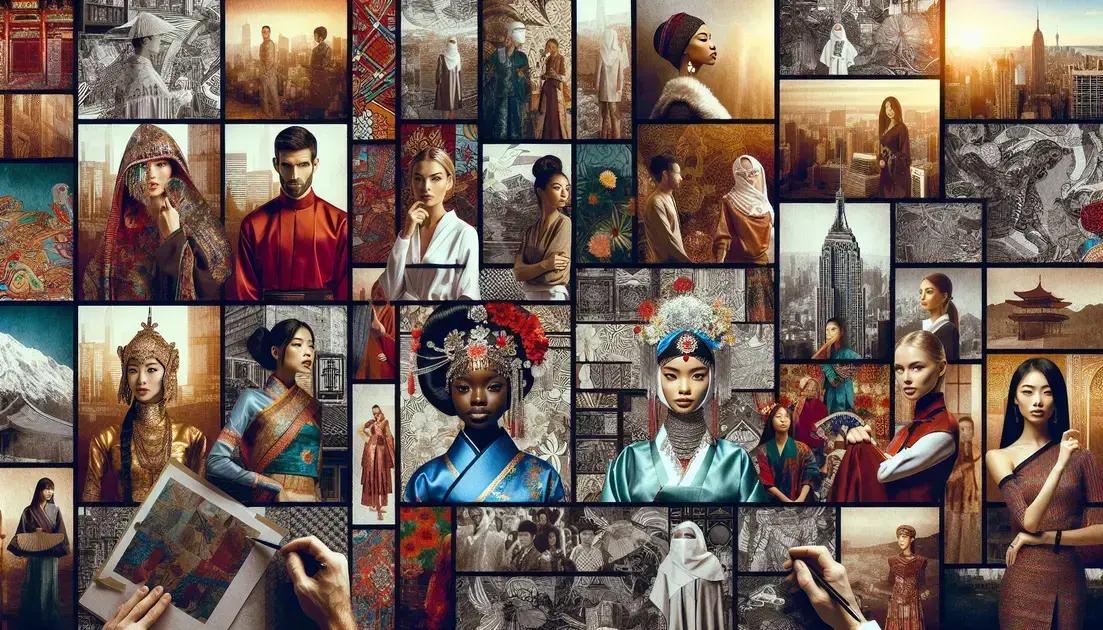The Evolution of Doramas: From TV Screens to Streaming Platforms
Anúncios
Discover the evolution of doramas from their TV origins to the exciting realm of streaming platforms. Once limited to specific regional broadcasts, doramas have transcended borders and reached global audiences through online platforms. This transformation has not only changed the way audiences consume content but has also revolutionized the industry itself. As we delve into this topic, we’ll explore key moments and transitions that shaped doramas’ journey from scheduled TV shows to on-demand streaming giants.
The Birth of Doramas on Traditional TV
The birth of doramas on traditional TV marked a significant cultural milestone. Originating from Japan and South Korea, these televised dramas offered audiences a blend of compelling storytelling, intricate characters, and rich cultural backdrops. Viewers were quickly captivated by the emotional depth and unique plots, often reflecting societal issues, historical events, or relatable contemporary dramas.
In the 1980s and 1990s, doramas became a staple of evening television, providing a much-needed escape and a means of connection for audiences of all ages. Many doramas were broadcast in prime time slots, allowing for maximum viewership and quickly gaining a loyal fan base. Their growing popularity solidified them as a core feature of television programming, paving the way for the diverse range of genres we enjoy today, from intense action thrillers to gentle romantic comedies.
These early productions set the foundation for what doramas would evolve into, combining traditional narrative techniques with emerging modern elements. As viewership grew, so did the ambition to produce higher-quality content, which led to doramas becoming a powerful force in redefining television entertainment.
Production Techniques and Innovations
The early doramas were characterized by distinct production methodologies that leveraged both technology and artistry. Directors and producers drew on theatrical practices, crafting each episode with attention to detail in set design and costume, aiming to bring authenticity to the screen.
Furthermore, the emphasis on strong, relatable characters allowed audiences to engage deeply with the storyline. Actors became household names, and their performances often contributed significantly to the dorama’s success, fostering a personal connection with viewers.
Impact of Early Doramas on Asian Culture

Early doramas significantly impacted Asian culture, creating a new form of storytelling that resonated deeply with viewers. These dramas often reflected everyday life, offering relatable narratives that conveyed societal values and customs. Through this medium, audiences connected with themes of family, friendship, and love, seeing reflections of their own lives on screen.
The cultural influence of doramas extended beyond entertainment. They served as a conduit for social dialogue, addressing issues like gender roles, generational conflicts, and cultural identity. As doramas portrayed complex characters in challenging situations, they provided a platform for audiences to explore and discuss important cultural topics.
Fashion and lifestyle depicted in doramas also played a role in shaping popular culture. Viewers often sought to emulate the styles of their favorite characters, influencing trends in clothing, hairstyles, and even language. The integration of traditional and modern elements mirrored the changing cultural landscape, allowing doramas to remain relevant and engaging.
Doramas as a Cultural Export
With their growing popularity, doramas began to transcend regional boundaries, becoming a cultural export. As international audiences discovered these dramas, they sparked an interest in Asian culture, leading to increased cultural exchange and understanding. This exposure allowed for a broader appreciation of cultural diversity and fostered curiosity about other lifestyles and traditions.
Furthermore, doramas contributed to the global spread of cultural products such as music, food, and tourism, drawing international visitors to locations famously depicted in these series. This cross-cultural influence highlighted the power of media in bridging cultural gaps and fostering global connections.
Shift from TV to Online Streaming – A New Era
The shift from TV to online streaming ushered in a new era for doramas, dramatically changing how audiences access and enjoy these shows. With the advent of digital platforms, viewers gained the ability to watch their favorite series anytime, anywhere. This flexibility opened up a world of opportunities for binge-watching and introduced doramas to a broader audience.
Streaming services offered vast libraries of content, eliminating geographical barriers that once restricted viewership. Fans from different parts of the world could now access episodes simultaneously, fostering international communities and discussions around doramas. This global reach enhanced the cultural exchange initiated by early television broadcasts.
The transition also affected the way doramas were produced and consumed. Creators began exploring diverse genres, capitalizing on the freedom from traditional network scheduling constraints. Episodes and seasons were tailored to streaming formats, often resulting in more concise storytelling and higher production values.
Challenges and Adaptations
Despite the benefits, this shift to streaming involved challenges. Traditional networks faced pressure to adapt, while producers navigated changing audience expectations. They had to balance maintaining the core appeal of doramas with embracing new formats and technologies.
Additionally, the accessibility of global content heightened competition, pushing dorama creators to innovate constantly. This environment motivated them to produce more dynamic content that captured the imagination of diverse audiences.
Key Players in the Transition to Streaming

Pivotal companies and individuals drove the movement of doramas onto streaming platforms, reshaping the entertainment landscape. With the rise of digital technology, traditional TV networks partnered with modern tech giants to offer their content online. This collaboration allowed doramas to reach audiences globally, expanding their fan base and influence.
Streaming giants like Netflix and Amazon Prime played significant roles. By including doramas in their catalogs, they provided easier access to these shows. Their investment in buying rights and promoting dorama content opened doors for non-Asian audiences to explore and enjoy these stories, increasing international appreciation and demand.
Local platforms also emerged as major players. Services like Viki and Kocowa specialized in offering Asian content, including doramas, with subtitles in multiple languages. These platforms targeted niche audiences, creating dedicated communities with a shared interest in Asian dramas.
Influence of Content Creators
Producers and directors were instrumental in adapting doramas for streaming. They experimented with new formats and storytelling techniques, taking advantage of the flexibility offered by online platforms. This innovation attracted diverse audience segments and encouraged the continual evolution of dorama content.
Moreover, user-generated content and fan communities on social media further propelled the popularity of streaming doramas. Fans actively engaged in translating and sharing episodes, creating memes, and organizing online discussions. Their enthusiasm and grassroots marketing contributed greatly to the success of doramas on streaming services.
How Streaming Changed Dorama Production and Content
Streaming changed dorama production by introducing new opportunities for creative expression and altering storytelling dynamics. Without the constraints of traditional broadcast schedules, producers explored diverse themes and formats. They could develop series with varying lengths, pacing, and styles, enhancing creativity and audience engagement.
The availability of higher budgets allowed for better production quality. Investment in advanced technology and special effects improved the visual appeal of doramas, making them more competitive on a global scale. This elevates the viewer experience, offering cinematic elements that captivate audiences.
Meanwhile, increased audience accessibility fostered inclusive content creation. Producers now cater to a wider range of interests and demographics, integrating multicultural elements and stories that resonate with international viewers. This trend expanded the narrative scope and helped doramas gain a broader appeal.
Interactive Features and Viewer Feedback
Streaming platforms have enhanced how viewers interact with content. Features like commenting, rating, and sharing provided instantaneous feedback, shaping future productions. Creators can quickly adapt to audience preferences, refining storylines and characters based on real-time viewer insights.
Moreover, the binge-watching model influenced how episodes are structured. Story arcs are planned to maintain high levels of excitement and engagement throughout, encouraging audiences to watch multiple episodes in one sitting. This shift leads to more engaging and cohesive storytelling.
Future Trends and Innovations in Dorama Streaming

Dorama streaming continues to evolve with emerging trends and innovations that promise to reshape the viewing experience. As technology advances, platforms are exploring ways to personalize content delivery. This includes using algorithms to tailor recommendations, ensuring viewers discover shows that match their interests and preferences.
Interactive storytelling is a significant trend, allowing audiences to influence the direction of plots. Viewers can make choices that affect outcomes, creating a more immersive experience. This level of interactivity not only engages audiences but also fosters deeper connections with the content.
Another innovation is the integration of augmented reality (AR) and virtual reality (VR) in dorama production. These technologies enhance storytelling by providing immersive environments that transport viewers into the world of doramas. While still in its infancy, the potential for AR and VR to transform consumption experiences is substantial.
Globalization and Collaboration
The globalization of dorama content is facilitated by international collaborations and co-productions. By partnering with creators from different regions, doramas can incorporate diverse cultural perspectives and themes, appealing to a broader audience.
Additionally, the rise of social media and fan engagement continues to drive innovations. Platforms are leveraging insights from these communities to create content that resonates globally. This dynamic feedback loop encourages ongoing experimentation and adaptation to meet the expectations of a worldwide fan base.
The Evolution of Doramas: Bridging Tradition and Innovation
The journey of doramas from traditional TV screens to modern streaming platforms highlights a remarkable evolution. Each phase—from their early influence on Asian culture to their global reach via streaming services—has contributed to their enduring popularity.
The transition to online platforms opened new possibilities for creativity, allowing producers to experiment with innovative storytelling techniques. Streaming not only enhanced accessibility but also introduced interactive and immersive experiences, broadening the dorama fan base across the globe.
Looking to the future, possibilities abound as technology continues to reshape the landscape. With the integration of AR and VR, international collaborations, and personalized viewing experiences, doramas are set to captivate audiences in ways never imagined before.
The evolution of doramas is a testament to their ability to adapt and flourish through changing times, bridging cultural traditions with modern innovation, and offering compelling stories that connect us all.







